Art History: Joan Mitchell and Women in Arts
VerifiedAdded on 2023/01/23
|10
|2788
|46
AI Summary
This article explores the art history of Joan Mitchell and the role of women in arts. It discusses Mitchell's inspirations and her unique approach to painting. It also highlights the impact of women in the art world and their contributions to social change.
Contribute Materials
Your contribution can guide someone’s learning journey. Share your
documents today.

Art history
Name
Institution
Professor
Course
Date
Name
Institution
Professor
Course
Date
Secure Best Marks with AI Grader
Need help grading? Try our AI Grader for instant feedback on your assignments.
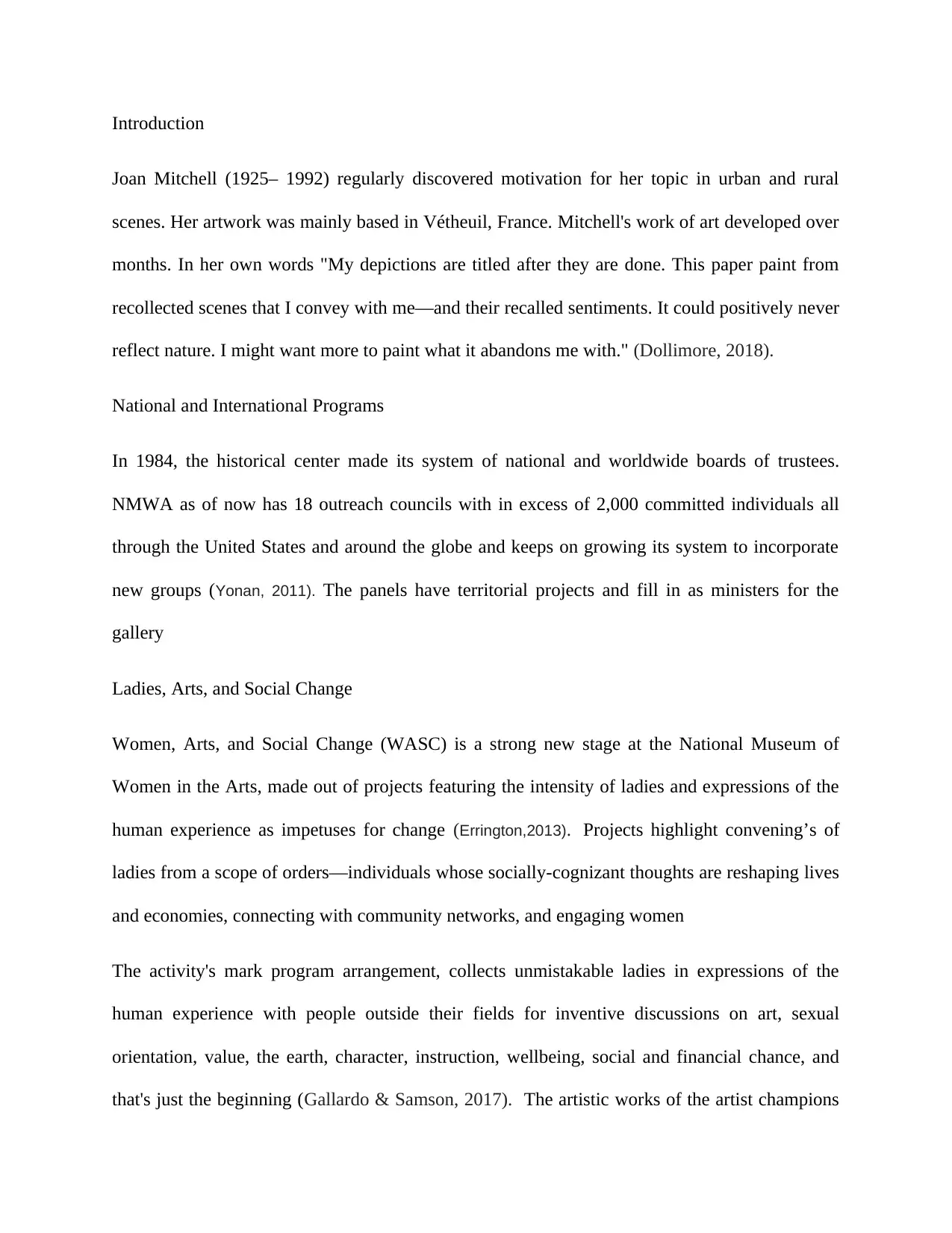
Introduction
Joan Mitchell (1925– 1992) regularly discovered motivation for her topic in urban and rural
scenes. Her artwork was mainly based in Vétheuil, France. Mitchell's work of art developed over
months. In her own words "My depictions are titled after they are done. This paper paint from
recollected scenes that I convey with me—and their recalled sentiments. It could positively never
reflect nature. I might want more to paint what it abandons me with." (Dollimore, 2018).
National and International Programs
In 1984, the historical center made its system of national and worldwide boards of trustees.
NMWA as of now has 18 outreach councils with in excess of 2,000 committed individuals all
through the United States and around the globe and keeps on growing its system to incorporate
new groups (Yonan, 2011). The panels have territorial projects and fill in as ministers for the
gallery
Ladies, Arts, and Social Change
Women, Arts, and Social Change (WASC) is a strong new stage at the National Museum of
Women in the Arts, made out of projects featuring the intensity of ladies and expressions of the
human experience as impetuses for change (Errington,2013). Projects highlight convening’s of
ladies from a scope of orders—individuals whose socially-cognizant thoughts are reshaping lives
and economies, connecting with community networks, and engaging women
The activity's mark program arrangement, collects unmistakable ladies in expressions of the
human experience with people outside their fields for inventive discussions on art, sexual
orientation, value, the earth, character, instruction, wellbeing, social and financial chance, and
that's just the beginning (Gallardo & Samson, 2017). The artistic works of the artist champions
Joan Mitchell (1925– 1992) regularly discovered motivation for her topic in urban and rural
scenes. Her artwork was mainly based in Vétheuil, France. Mitchell's work of art developed over
months. In her own words "My depictions are titled after they are done. This paper paint from
recollected scenes that I convey with me—and their recalled sentiments. It could positively never
reflect nature. I might want more to paint what it abandons me with." (Dollimore, 2018).
National and International Programs
In 1984, the historical center made its system of national and worldwide boards of trustees.
NMWA as of now has 18 outreach councils with in excess of 2,000 committed individuals all
through the United States and around the globe and keeps on growing its system to incorporate
new groups (Yonan, 2011). The panels have territorial projects and fill in as ministers for the
gallery
Ladies, Arts, and Social Change
Women, Arts, and Social Change (WASC) is a strong new stage at the National Museum of
Women in the Arts, made out of projects featuring the intensity of ladies and expressions of the
human experience as impetuses for change (Errington,2013). Projects highlight convening’s of
ladies from a scope of orders—individuals whose socially-cognizant thoughts are reshaping lives
and economies, connecting with community networks, and engaging women
The activity's mark program arrangement, collects unmistakable ladies in expressions of the
human experience with people outside their fields for inventive discussions on art, sexual
orientation, value, the earth, character, instruction, wellbeing, social and financial chance, and
that's just the beginning (Gallardo & Samson, 2017). The artistic works of the artist champions
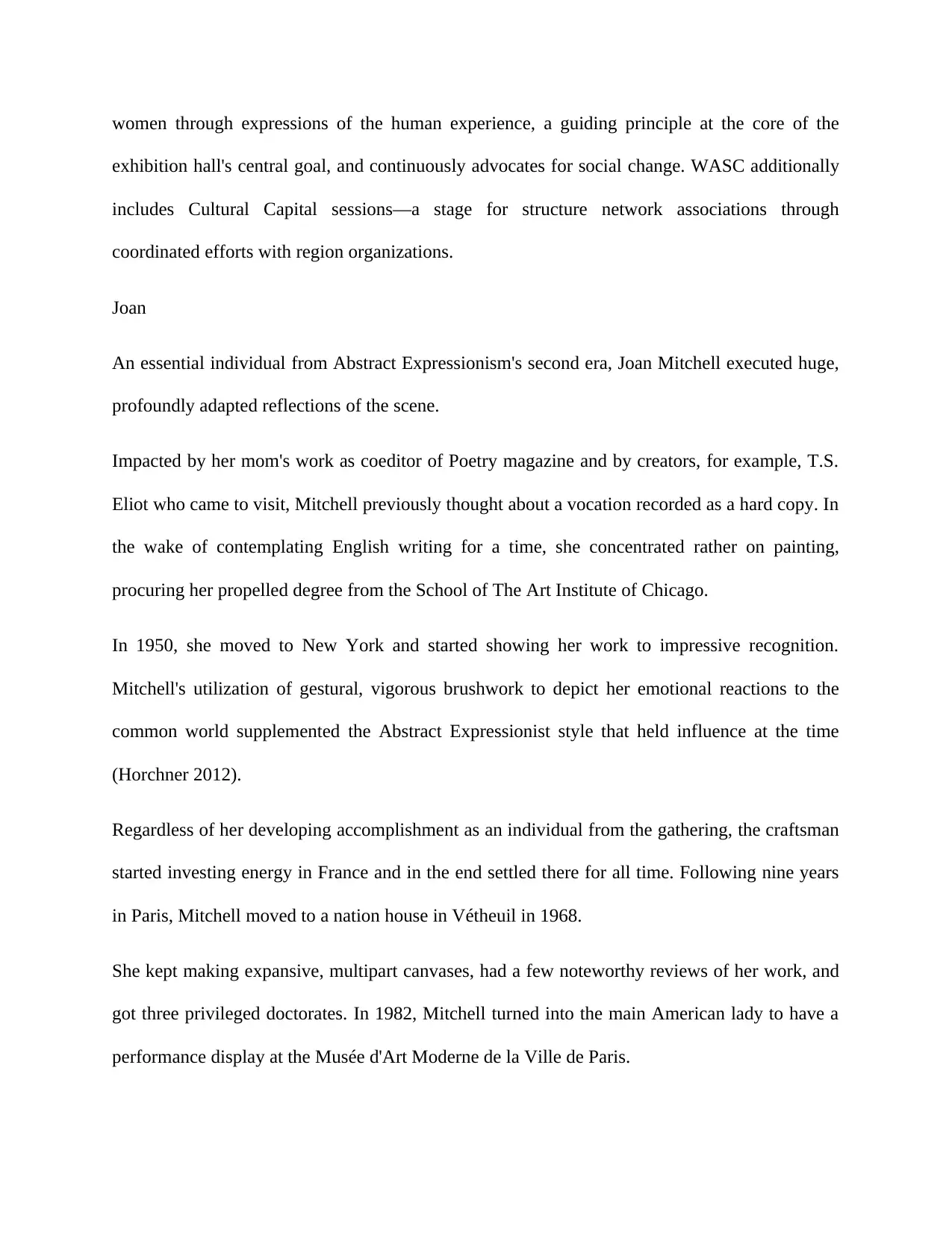
women through expressions of the human experience, a guiding principle at the core of the
exhibition hall's central goal, and continuously advocates for social change. WASC additionally
includes Cultural Capital sessions—a stage for structure network associations through
coordinated efforts with region organizations.
Joan
An essential individual from Abstract Expressionism's second era, Joan Mitchell executed huge,
profoundly adapted reflections of the scene.
Impacted by her mom's work as coeditor of Poetry magazine and by creators, for example, T.S.
Eliot who came to visit, Mitchell previously thought about a vocation recorded as a hard copy. In
the wake of contemplating English writing for a time, she concentrated rather on painting,
procuring her propelled degree from the School of The Art Institute of Chicago.
In 1950, she moved to New York and started showing her work to impressive recognition.
Mitchell's utilization of gestural, vigorous brushwork to depict her emotional reactions to the
common world supplemented the Abstract Expressionist style that held influence at the time
(Horchner 2012).
Regardless of her developing accomplishment as an individual from the gathering, the craftsman
started investing energy in France and in the end settled there for all time. Following nine years
in Paris, Mitchell moved to a nation house in Vétheuil in 1968.
She kept making expansive, multipart canvases, had a few noteworthy reviews of her work, and
got three privileged doctorates. In 1982, Mitchell turned into the main American lady to have a
performance display at the Musée d'Art Moderne de la Ville de Paris.
exhibition hall's central goal, and continuously advocates for social change. WASC additionally
includes Cultural Capital sessions—a stage for structure network associations through
coordinated efforts with region organizations.
Joan
An essential individual from Abstract Expressionism's second era, Joan Mitchell executed huge,
profoundly adapted reflections of the scene.
Impacted by her mom's work as coeditor of Poetry magazine and by creators, for example, T.S.
Eliot who came to visit, Mitchell previously thought about a vocation recorded as a hard copy. In
the wake of contemplating English writing for a time, she concentrated rather on painting,
procuring her propelled degree from the School of The Art Institute of Chicago.
In 1950, she moved to New York and started showing her work to impressive recognition.
Mitchell's utilization of gestural, vigorous brushwork to depict her emotional reactions to the
common world supplemented the Abstract Expressionist style that held influence at the time
(Horchner 2012).
Regardless of her developing accomplishment as an individual from the gathering, the craftsman
started investing energy in France and in the end settled there for all time. Following nine years
in Paris, Mitchell moved to a nation house in Vétheuil in 1968.
She kept making expansive, multipart canvases, had a few noteworthy reviews of her work, and
got three privileged doctorates. In 1982, Mitchell turned into the main American lady to have a
performance display at the Musée d'Art Moderne de la Ville de Paris.
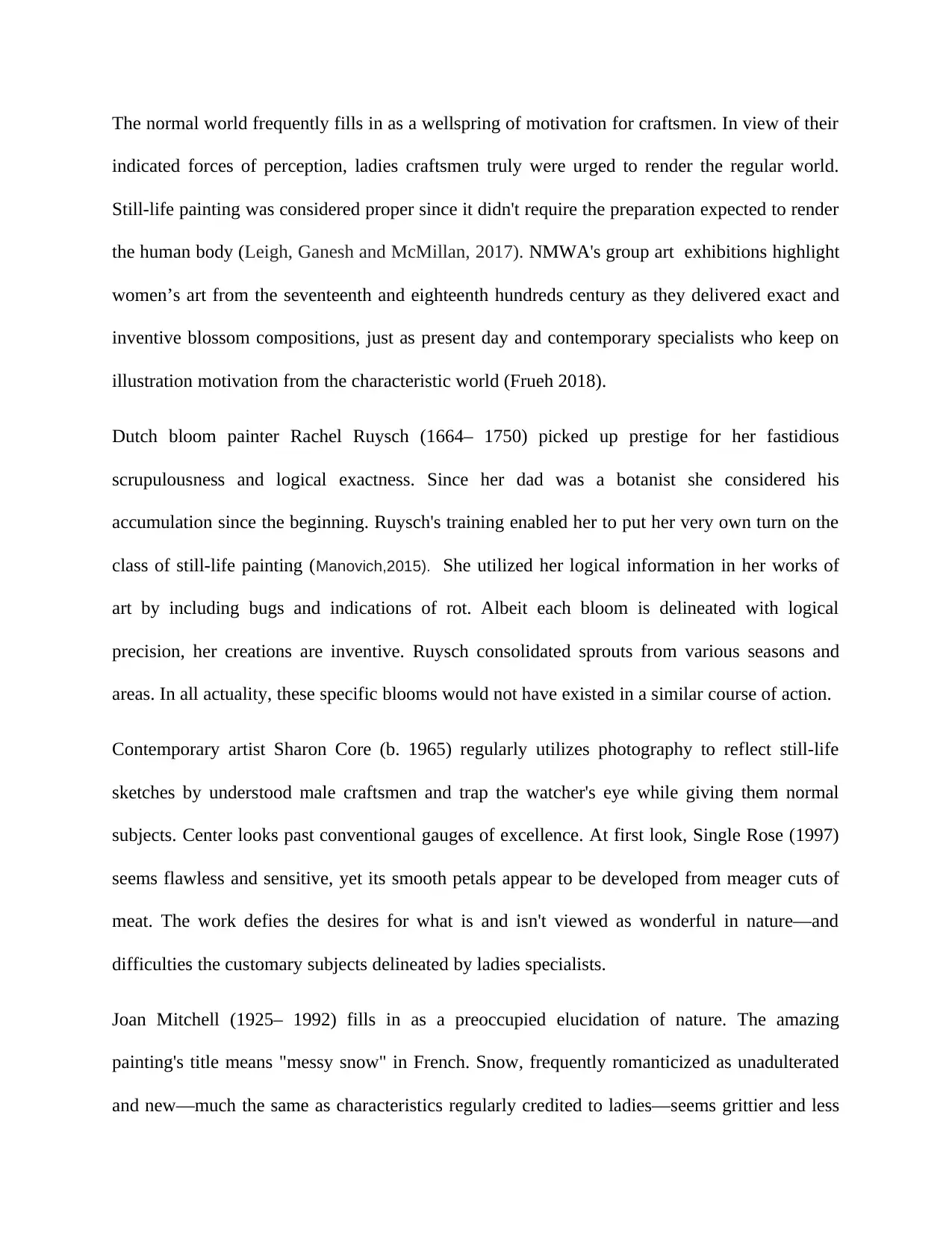
The normal world frequently fills in as a wellspring of motivation for craftsmen. In view of their
indicated forces of perception, ladies craftsmen truly were urged to render the regular world.
Still-life painting was considered proper since it didn't require the preparation expected to render
the human body (Leigh, Ganesh and McMillan, 2017). NMWA's group art exhibitions highlight
women’s art from the seventeenth and eighteenth hundreds century as they delivered exact and
inventive blossom compositions, just as present day and contemporary specialists who keep on
illustration motivation from the characteristic world (Frueh 2018).
Dutch bloom painter Rachel Ruysch (1664– 1750) picked up prestige for her fastidious
scrupulousness and logical exactness. Since her dad was a botanist she considered his
accumulation since the beginning. Ruysch's training enabled her to put her very own turn on the
class of still-life painting (Manovich,2015). She utilized her logical information in her works of
art by including bugs and indications of rot. Albeit each bloom is delineated with logical
precision, her creations are inventive. Ruysch consolidated sprouts from various seasons and
areas. In all actuality, these specific blooms would not have existed in a similar course of action.
Contemporary artist Sharon Core (b. 1965) regularly utilizes photography to reflect still-life
sketches by understood male craftsmen and trap the watcher's eye while giving them normal
subjects. Center looks past conventional gauges of excellence. At first look, Single Rose (1997)
seems flawless and sensitive, yet its smooth petals appear to be developed from meager cuts of
meat. The work defies the desires for what is and isn't viewed as wonderful in nature—and
difficulties the customary subjects delineated by ladies specialists.
Joan Mitchell (1925– 1992) fills in as a preoccupied elucidation of nature. The amazing
painting's title means "messy snow" in French. Snow, frequently romanticized as unadulterated
and new—much the same as characteristics regularly credited to ladies—seems grittier and less
indicated forces of perception, ladies craftsmen truly were urged to render the regular world.
Still-life painting was considered proper since it didn't require the preparation expected to render
the human body (Leigh, Ganesh and McMillan, 2017). NMWA's group art exhibitions highlight
women’s art from the seventeenth and eighteenth hundreds century as they delivered exact and
inventive blossom compositions, just as present day and contemporary specialists who keep on
illustration motivation from the characteristic world (Frueh 2018).
Dutch bloom painter Rachel Ruysch (1664– 1750) picked up prestige for her fastidious
scrupulousness and logical exactness. Since her dad was a botanist she considered his
accumulation since the beginning. Ruysch's training enabled her to put her very own turn on the
class of still-life painting (Manovich,2015). She utilized her logical information in her works of
art by including bugs and indications of rot. Albeit each bloom is delineated with logical
precision, her creations are inventive. Ruysch consolidated sprouts from various seasons and
areas. In all actuality, these specific blooms would not have existed in a similar course of action.
Contemporary artist Sharon Core (b. 1965) regularly utilizes photography to reflect still-life
sketches by understood male craftsmen and trap the watcher's eye while giving them normal
subjects. Center looks past conventional gauges of excellence. At first look, Single Rose (1997)
seems flawless and sensitive, yet its smooth petals appear to be developed from meager cuts of
meat. The work defies the desires for what is and isn't viewed as wonderful in nature—and
difficulties the customary subjects delineated by ladies specialists.
Joan Mitchell (1925– 1992) fills in as a preoccupied elucidation of nature. The amazing
painting's title means "messy snow" in French. Snow, frequently romanticized as unadulterated
and new—much the same as characteristics regularly credited to ladies—seems grittier and less
Secure Best Marks with AI Grader
Need help grading? Try our AI Grader for instant feedback on your assignments.
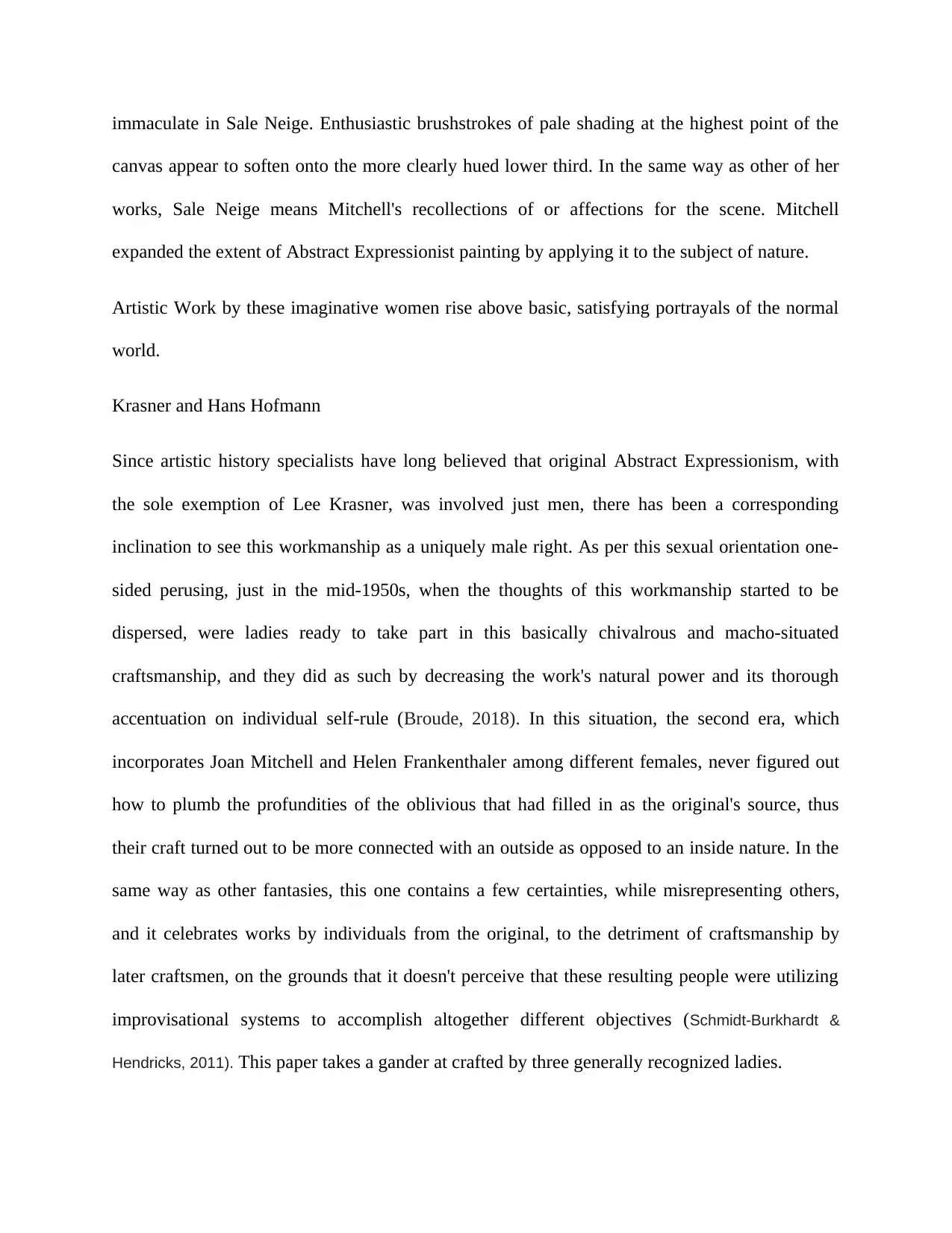
immaculate in Sale Neige. Enthusiastic brushstrokes of pale shading at the highest point of the
canvas appear to soften onto the more clearly hued lower third. In the same way as other of her
works, Sale Neige means Mitchell's recollections of or affections for the scene. Mitchell
expanded the extent of Abstract Expressionist painting by applying it to the subject of nature.
Artistic Work by these imaginative women rise above basic, satisfying portrayals of the normal
world.
Krasner and Hans Hofmann
Since artistic history specialists have long believed that original Abstract Expressionism, with
the sole exemption of Lee Krasner, was involved just men, there has been a corresponding
inclination to see this workmanship as a uniquely male right. As per this sexual orientation one-
sided perusing, just in the mid-1950s, when the thoughts of this workmanship started to be
dispersed, were ladies ready to take part in this basically chivalrous and macho-situated
craftsmanship, and they did as such by decreasing the work's natural power and its thorough
accentuation on individual self-rule (Broude, 2018). In this situation, the second era, which
incorporates Joan Mitchell and Helen Frankenthaler among different females, never figured out
how to plumb the profundities of the oblivious that had filled in as the original's source, thus
their craft turned out to be more connected with an outside as opposed to an inside nature. In the
same way as other fantasies, this one contains a few certainties, while misrepresenting others,
and it celebrates works by individuals from the original, to the detriment of craftsmanship by
later craftsmen, on the grounds that it doesn't perceive that these resulting people were utilizing
improvisational systems to accomplish altogether different objectives (Schmidt-Burkhardt &
Hendricks, 2011). This paper takes a gander at crafted by three generally recognized ladies.
canvas appear to soften onto the more clearly hued lower third. In the same way as other of her
works, Sale Neige means Mitchell's recollections of or affections for the scene. Mitchell
expanded the extent of Abstract Expressionist painting by applying it to the subject of nature.
Artistic Work by these imaginative women rise above basic, satisfying portrayals of the normal
world.
Krasner and Hans Hofmann
Since artistic history specialists have long believed that original Abstract Expressionism, with
the sole exemption of Lee Krasner, was involved just men, there has been a corresponding
inclination to see this workmanship as a uniquely male right. As per this sexual orientation one-
sided perusing, just in the mid-1950s, when the thoughts of this workmanship started to be
dispersed, were ladies ready to take part in this basically chivalrous and macho-situated
craftsmanship, and they did as such by decreasing the work's natural power and its thorough
accentuation on individual self-rule (Broude, 2018). In this situation, the second era, which
incorporates Joan Mitchell and Helen Frankenthaler among different females, never figured out
how to plumb the profundities of the oblivious that had filled in as the original's source, thus
their craft turned out to be more connected with an outside as opposed to an inside nature. In the
same way as other fantasies, this one contains a few certainties, while misrepresenting others,
and it celebrates works by individuals from the original, to the detriment of craftsmanship by
later craftsmen, on the grounds that it doesn't perceive that these resulting people were utilizing
improvisational systems to accomplish altogether different objectives (Schmidt-Burkhardt &
Hendricks, 2011). This paper takes a gander at crafted by three generally recognized ladies.
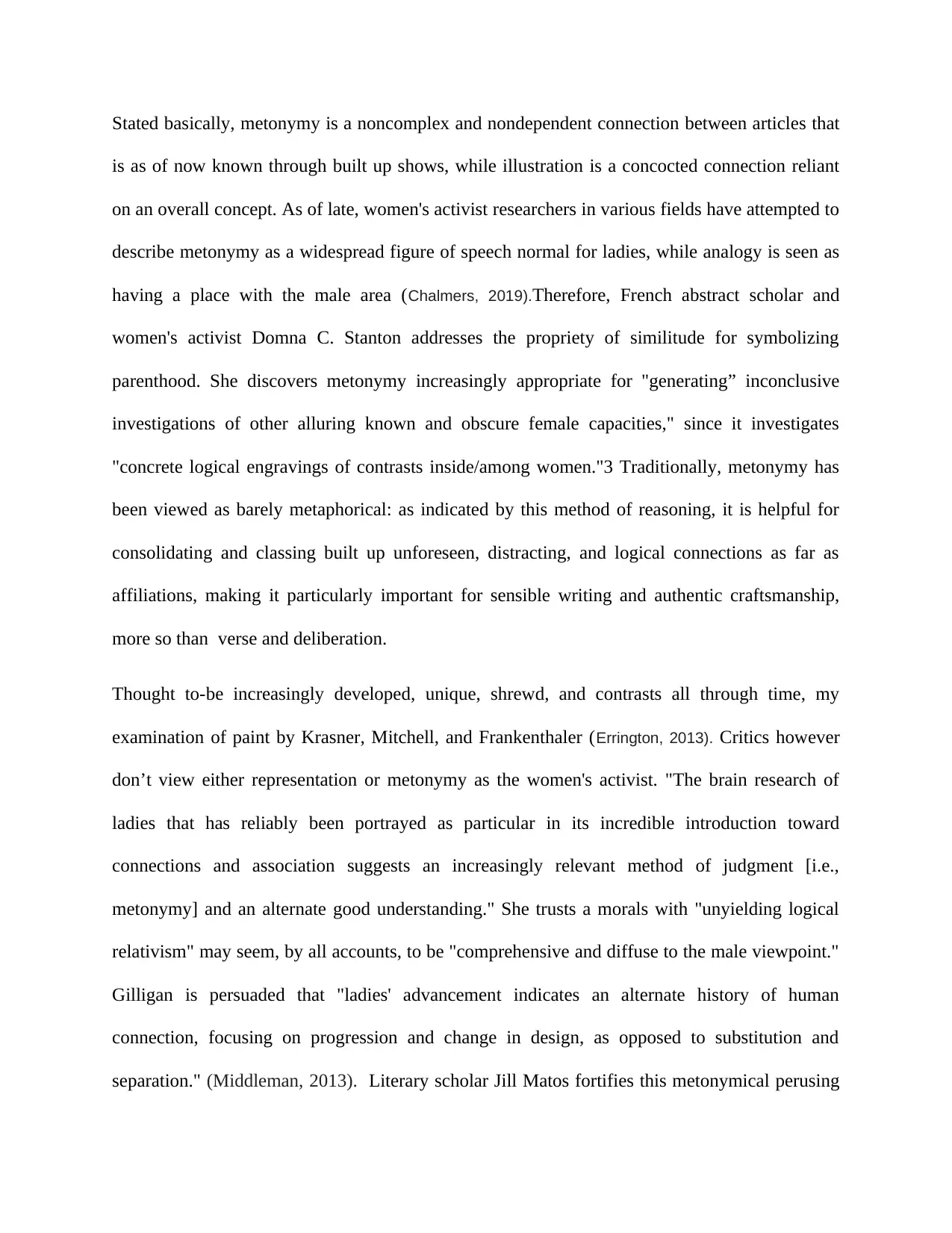
Stated basically, metonymy is a noncomplex and nondependent connection between articles that
is as of now known through built up shows, while illustration is a concocted connection reliant
on an overall concept. As of late, women's activist researchers in various fields have attempted to
describe metonymy as a widespread figure of speech normal for ladies, while analogy is seen as
having a place with the male area (Chalmers, 2019).Therefore, French abstract scholar and
women's activist Domna C. Stanton addresses the propriety of similitude for symbolizing
parenthood. She discovers metonymy increasingly appropriate for "generating” inconclusive
investigations of other alluring known and obscure female capacities," since it investigates
"concrete logical engravings of contrasts inside/among women."3 Traditionally, metonymy has
been viewed as barely metaphorical: as indicated by this method of reasoning, it is helpful for
consolidating and classing built up unforeseen, distracting, and logical connections as far as
affiliations, making it particularly important for sensible writing and authentic craftsmanship,
more so than verse and deliberation.
Thought to-be increasingly developed, unique, shrewd, and contrasts all through time, my
examination of paint by Krasner, Mitchell, and Frankenthaler (Errington, 2013). Critics however
don’t view either representation or metonymy as the women's activist. "The brain research of
ladies that has reliably been portrayed as particular in its incredible introduction toward
connections and association suggests an increasingly relevant method of judgment [i.e.,
metonymy] and an alternate good understanding." She trusts a morals with "unyielding logical
relativism" may seem, by all accounts, to be "comprehensive and diffuse to the male viewpoint."
Gilligan is persuaded that "ladies' advancement indicates an alternate history of human
connection, focusing on progression and change in design, as opposed to substitution and
separation." (Middleman, 2013). Literary scholar Jill Matos fortifies this metonymical perusing
is as of now known through built up shows, while illustration is a concocted connection reliant
on an overall concept. As of late, women's activist researchers in various fields have attempted to
describe metonymy as a widespread figure of speech normal for ladies, while analogy is seen as
having a place with the male area (Chalmers, 2019).Therefore, French abstract scholar and
women's activist Domna C. Stanton addresses the propriety of similitude for symbolizing
parenthood. She discovers metonymy increasingly appropriate for "generating” inconclusive
investigations of other alluring known and obscure female capacities," since it investigates
"concrete logical engravings of contrasts inside/among women."3 Traditionally, metonymy has
been viewed as barely metaphorical: as indicated by this method of reasoning, it is helpful for
consolidating and classing built up unforeseen, distracting, and logical connections as far as
affiliations, making it particularly important for sensible writing and authentic craftsmanship,
more so than verse and deliberation.
Thought to-be increasingly developed, unique, shrewd, and contrasts all through time, my
examination of paint by Krasner, Mitchell, and Frankenthaler (Errington, 2013). Critics however
don’t view either representation or metonymy as the women's activist. "The brain research of
ladies that has reliably been portrayed as particular in its incredible introduction toward
connections and association suggests an increasingly relevant method of judgment [i.e.,
metonymy] and an alternate good understanding." She trusts a morals with "unyielding logical
relativism" may seem, by all accounts, to be "comprehensive and diffuse to the male viewpoint."
Gilligan is persuaded that "ladies' advancement indicates an alternate history of human
connection, focusing on progression and change in design, as opposed to substitution and
separation." (Middleman, 2013). Literary scholar Jill Matos fortifies this metonymical perusing
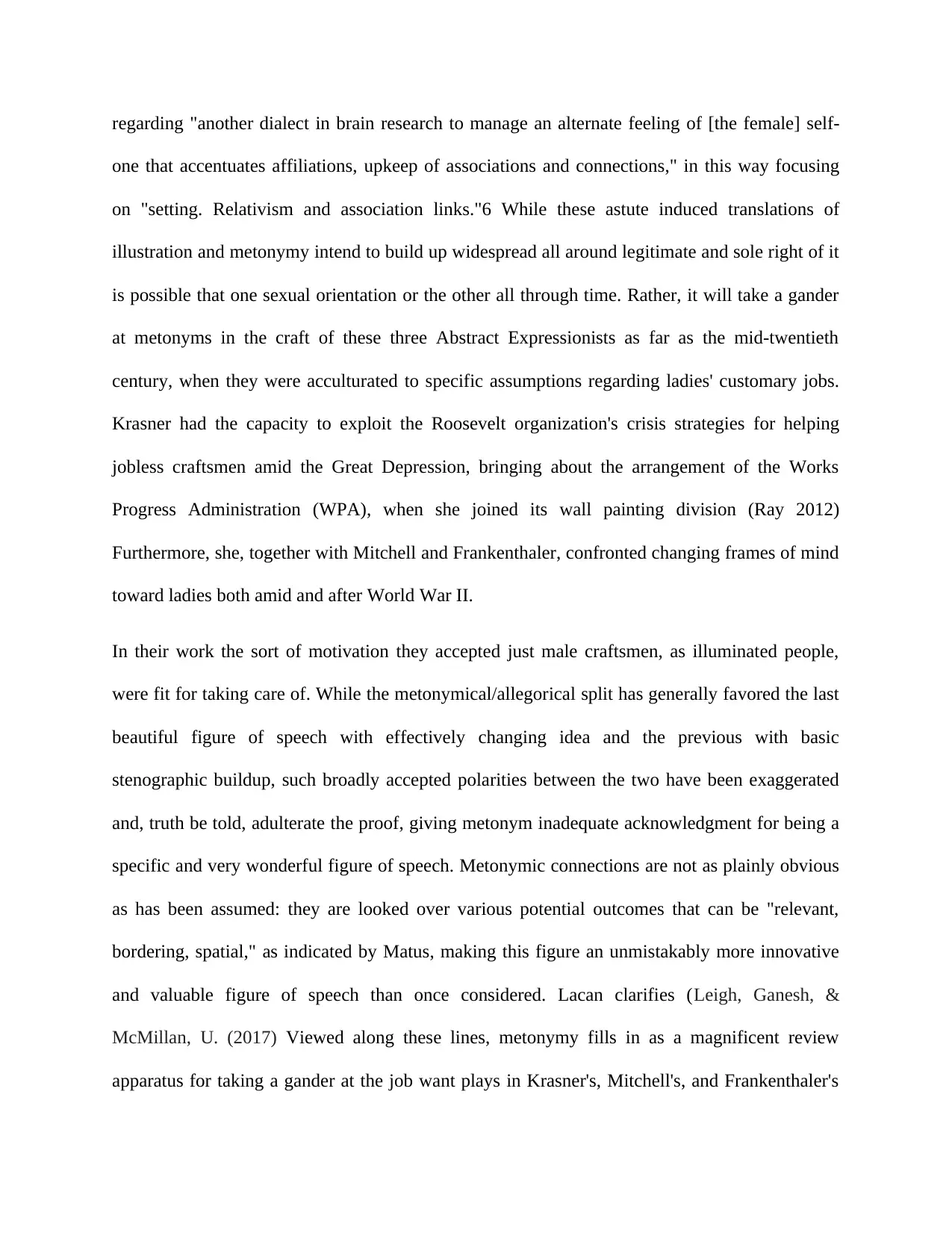
regarding "another dialect in brain research to manage an alternate feeling of [the female] self-
one that accentuates affiliations, upkeep of associations and connections," in this way focusing
on "setting. Relativism and association links."6 While these astute induced translations of
illustration and metonymy intend to build up widespread all around legitimate and sole right of it
is possible that one sexual orientation or the other all through time. Rather, it will take a gander
at metonyms in the craft of these three Abstract Expressionists as far as the mid-twentieth
century, when they were acculturated to specific assumptions regarding ladies' customary jobs.
Krasner had the capacity to exploit the Roosevelt organization's crisis strategies for helping
jobless craftsmen amid the Great Depression, bringing about the arrangement of the Works
Progress Administration (WPA), when she joined its wall painting division (Ray 2012)
Furthermore, she, together with Mitchell and Frankenthaler, confronted changing frames of mind
toward ladies both amid and after World War II.
In their work the sort of motivation they accepted just male craftsmen, as illuminated people,
were fit for taking care of. While the metonymical/allegorical split has generally favored the last
beautiful figure of speech with effectively changing idea and the previous with basic
stenographic buildup, such broadly accepted polarities between the two have been exaggerated
and, truth be told, adulterate the proof, giving metonym inadequate acknowledgment for being a
specific and very wonderful figure of speech. Metonymic connections are not as plainly obvious
as has been assumed: they are looked over various potential outcomes that can be "relevant,
bordering, spatial," as indicated by Matus, making this figure an unmistakably more innovative
and valuable figure of speech than once considered. Lacan clarifies (Leigh, Ganesh, &
McMillan, U. (2017) Viewed along these lines, metonymy fills in as a magnificent review
apparatus for taking a gander at the job want plays in Krasner's, Mitchell's, and Frankenthaler's
one that accentuates affiliations, upkeep of associations and connections," in this way focusing
on "setting. Relativism and association links."6 While these astute induced translations of
illustration and metonymy intend to build up widespread all around legitimate and sole right of it
is possible that one sexual orientation or the other all through time. Rather, it will take a gander
at metonyms in the craft of these three Abstract Expressionists as far as the mid-twentieth
century, when they were acculturated to specific assumptions regarding ladies' customary jobs.
Krasner had the capacity to exploit the Roosevelt organization's crisis strategies for helping
jobless craftsmen amid the Great Depression, bringing about the arrangement of the Works
Progress Administration (WPA), when she joined its wall painting division (Ray 2012)
Furthermore, she, together with Mitchell and Frankenthaler, confronted changing frames of mind
toward ladies both amid and after World War II.
In their work the sort of motivation they accepted just male craftsmen, as illuminated people,
were fit for taking care of. While the metonymical/allegorical split has generally favored the last
beautiful figure of speech with effectively changing idea and the previous with basic
stenographic buildup, such broadly accepted polarities between the two have been exaggerated
and, truth be told, adulterate the proof, giving metonym inadequate acknowledgment for being a
specific and very wonderful figure of speech. Metonymic connections are not as plainly obvious
as has been assumed: they are looked over various potential outcomes that can be "relevant,
bordering, spatial," as indicated by Matus, making this figure an unmistakably more innovative
and valuable figure of speech than once considered. Lacan clarifies (Leigh, Ganesh, &
McMillan, U. (2017) Viewed along these lines, metonymy fills in as a magnificent review
apparatus for taking a gander at the job want plays in Krasner's, Mitchell's, and Frankenthaler's
Paraphrase This Document
Need a fresh take? Get an instant paraphrase of this document with our AI Paraphraser
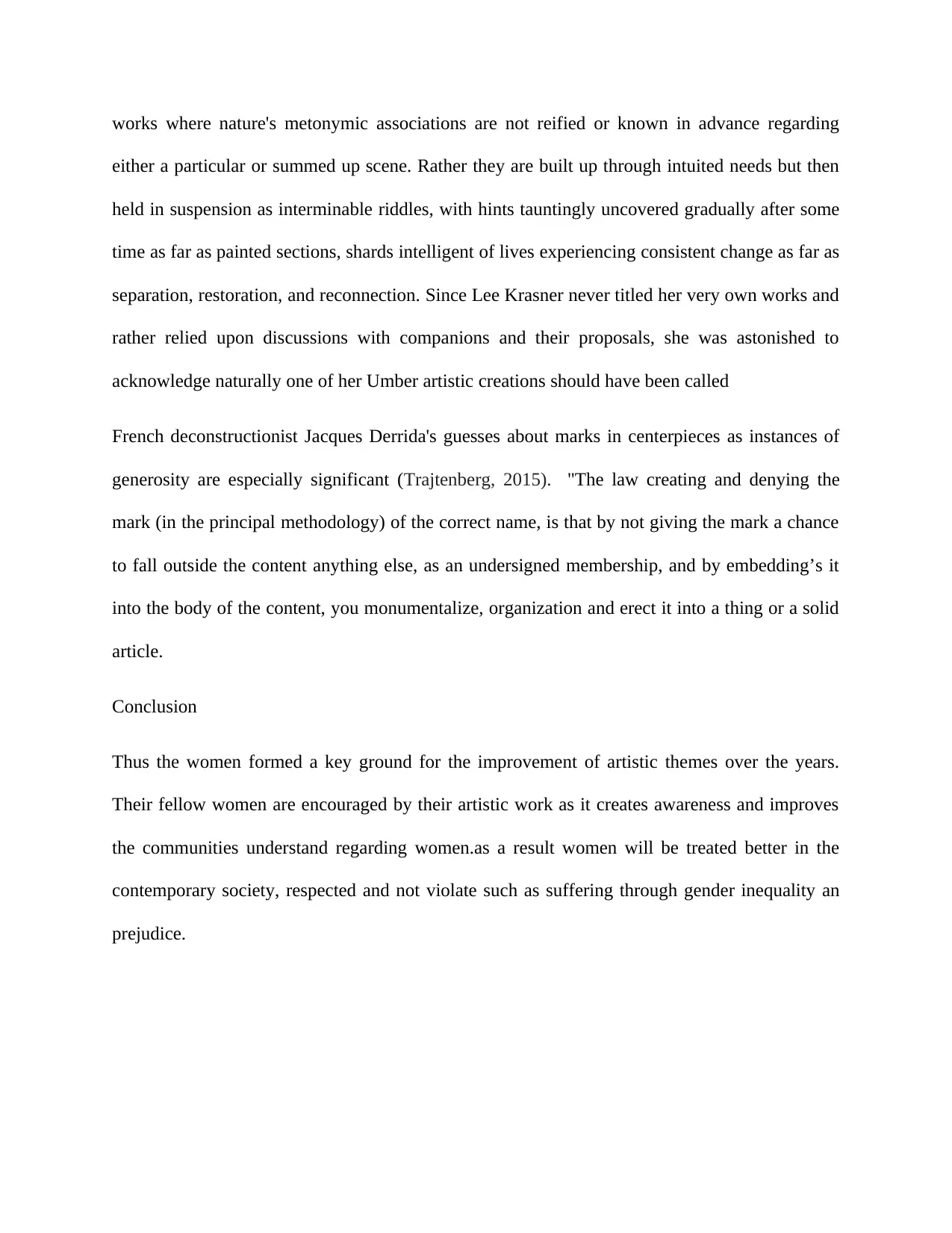
works where nature's metonymic associations are not reified or known in advance regarding
either a particular or summed up scene. Rather they are built up through intuited needs but then
held in suspension as interminable riddles, with hints tauntingly uncovered gradually after some
time as far as painted sections, shards intelligent of lives experiencing consistent change as far as
separation, restoration, and reconnection. Since Lee Krasner never titled her very own works and
rather relied upon discussions with companions and their proposals, she was astonished to
acknowledge naturally one of her Umber artistic creations should have been called
French deconstructionist Jacques Derrida's guesses about marks in centerpieces as instances of
generosity are especially significant (Trajtenberg, 2015). "The law creating and denying the
mark (in the principal methodology) of the correct name, is that by not giving the mark a chance
to fall outside the content anything else, as an undersigned membership, and by embedding’s it
into the body of the content, you monumentalize, organization and erect it into a thing or a solid
article.
Conclusion
Thus the women formed a key ground for the improvement of artistic themes over the years.
Their fellow women are encouraged by their artistic work as it creates awareness and improves
the communities understand regarding women.as a result women will be treated better in the
contemporary society, respected and not violate such as suffering through gender inequality an
prejudice.
either a particular or summed up scene. Rather they are built up through intuited needs but then
held in suspension as interminable riddles, with hints tauntingly uncovered gradually after some
time as far as painted sections, shards intelligent of lives experiencing consistent change as far as
separation, restoration, and reconnection. Since Lee Krasner never titled her very own works and
rather relied upon discussions with companions and their proposals, she was astonished to
acknowledge naturally one of her Umber artistic creations should have been called
French deconstructionist Jacques Derrida's guesses about marks in centerpieces as instances of
generosity are especially significant (Trajtenberg, 2015). "The law creating and denying the
mark (in the principal methodology) of the correct name, is that by not giving the mark a chance
to fall outside the content anything else, as an undersigned membership, and by embedding’s it
into the body of the content, you monumentalize, organization and erect it into a thing or a solid
article.
Conclusion
Thus the women formed a key ground for the improvement of artistic themes over the years.
Their fellow women are encouraged by their artistic work as it creates awareness and improves
the communities understand regarding women.as a result women will be treated better in the
contemporary society, respected and not violate such as suffering through gender inequality an
prejudice.
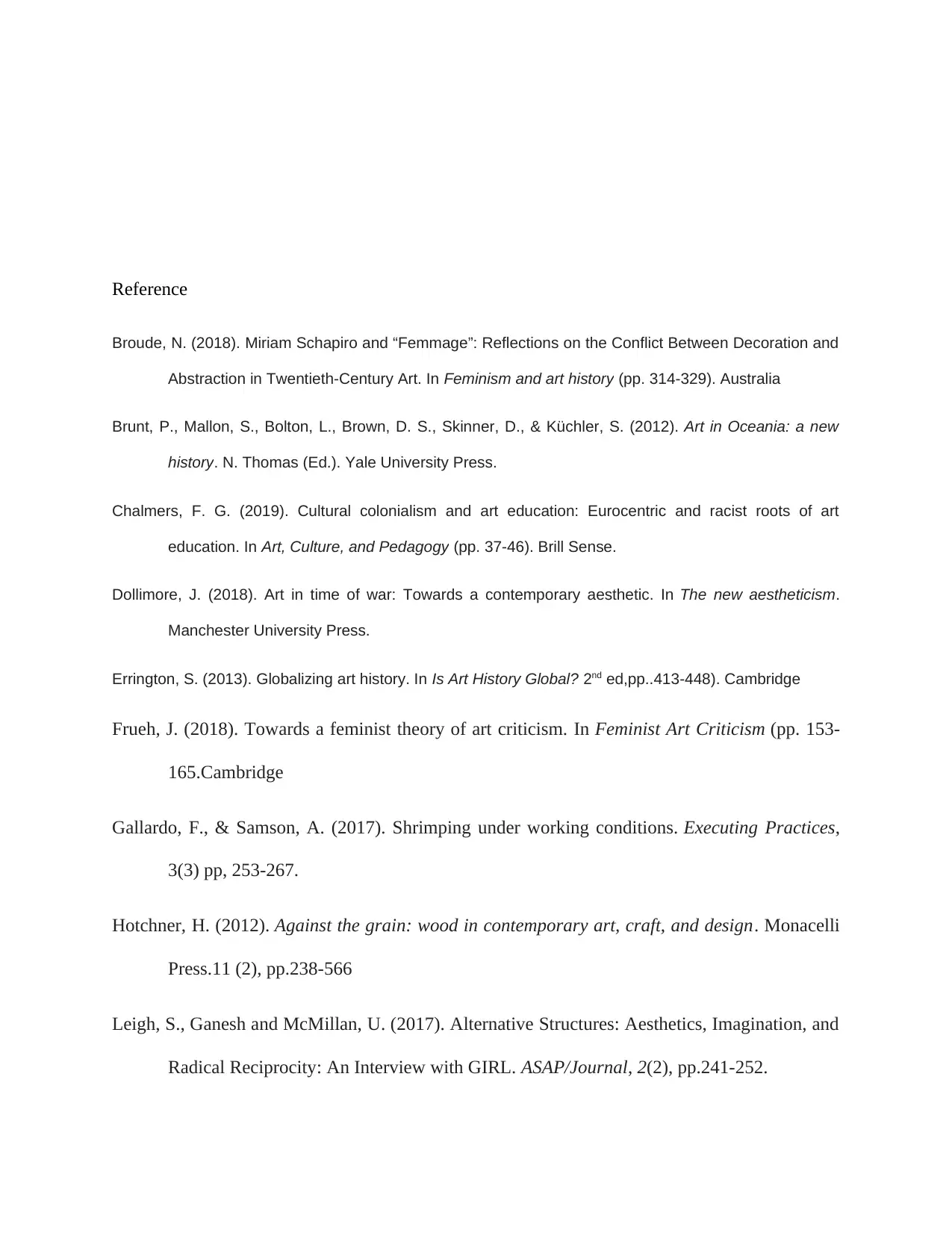
Reference
Broude, N. (2018). Miriam Schapiro and “Femmage”: Reflections on the Conflict Between Decoration and
Abstraction in Twentieth-Century Art. In Feminism and art history (pp. 314-329). Australia
Brunt, P., Mallon, S., Bolton, L., Brown, D. S., Skinner, D., & Küchler, S. (2012). Art in Oceania: a new
history. N. Thomas (Ed.). Yale University Press.
Chalmers, F. G. (2019). Cultural colonialism and art education: Eurocentric and racist roots of art
education. In Art, Culture, and Pedagogy (pp. 37-46). Brill Sense.
Dollimore, J. (2018). Art in time of war: Towards a contemporary aesthetic. In The new aestheticism.
Manchester University Press.
Errington, S. (2013). Globalizing art history. In Is Art History Global? 2nd ed,pp..413-448). Cambridge
Frueh, J. (2018). Towards a feminist theory of art criticism. In Feminist Art Criticism (pp. 153-
165.Cambridge
Gallardo, F., & Samson, A. (2017). Shrimping under working conditions. Executing Practices,
3(3) pp, 253-267.
Hotchner, H. (2012). Against the grain: wood in contemporary art, craft, and design. Monacelli
Press.11 (2), pp.238-566
Leigh, S., Ganesh and McMillan, U. (2017). Alternative Structures: Aesthetics, Imagination, and
Radical Reciprocity: An Interview with GIRL. ASAP/Journal, 2(2), pp.241-252.
Broude, N. (2018). Miriam Schapiro and “Femmage”: Reflections on the Conflict Between Decoration and
Abstraction in Twentieth-Century Art. In Feminism and art history (pp. 314-329). Australia
Brunt, P., Mallon, S., Bolton, L., Brown, D. S., Skinner, D., & Küchler, S. (2012). Art in Oceania: a new
history. N. Thomas (Ed.). Yale University Press.
Chalmers, F. G. (2019). Cultural colonialism and art education: Eurocentric and racist roots of art
education. In Art, Culture, and Pedagogy (pp. 37-46). Brill Sense.
Dollimore, J. (2018). Art in time of war: Towards a contemporary aesthetic. In The new aestheticism.
Manchester University Press.
Errington, S. (2013). Globalizing art history. In Is Art History Global? 2nd ed,pp..413-448). Cambridge
Frueh, J. (2018). Towards a feminist theory of art criticism. In Feminist Art Criticism (pp. 153-
165.Cambridge
Gallardo, F., & Samson, A. (2017). Shrimping under working conditions. Executing Practices,
3(3) pp, 253-267.
Hotchner, H. (2012). Against the grain: wood in contemporary art, craft, and design. Monacelli
Press.11 (2), pp.238-566
Leigh, S., Ganesh and McMillan, U. (2017). Alternative Structures: Aesthetics, Imagination, and
Radical Reciprocity: An Interview with GIRL. ASAP/Journal, 2(2), pp.241-252.
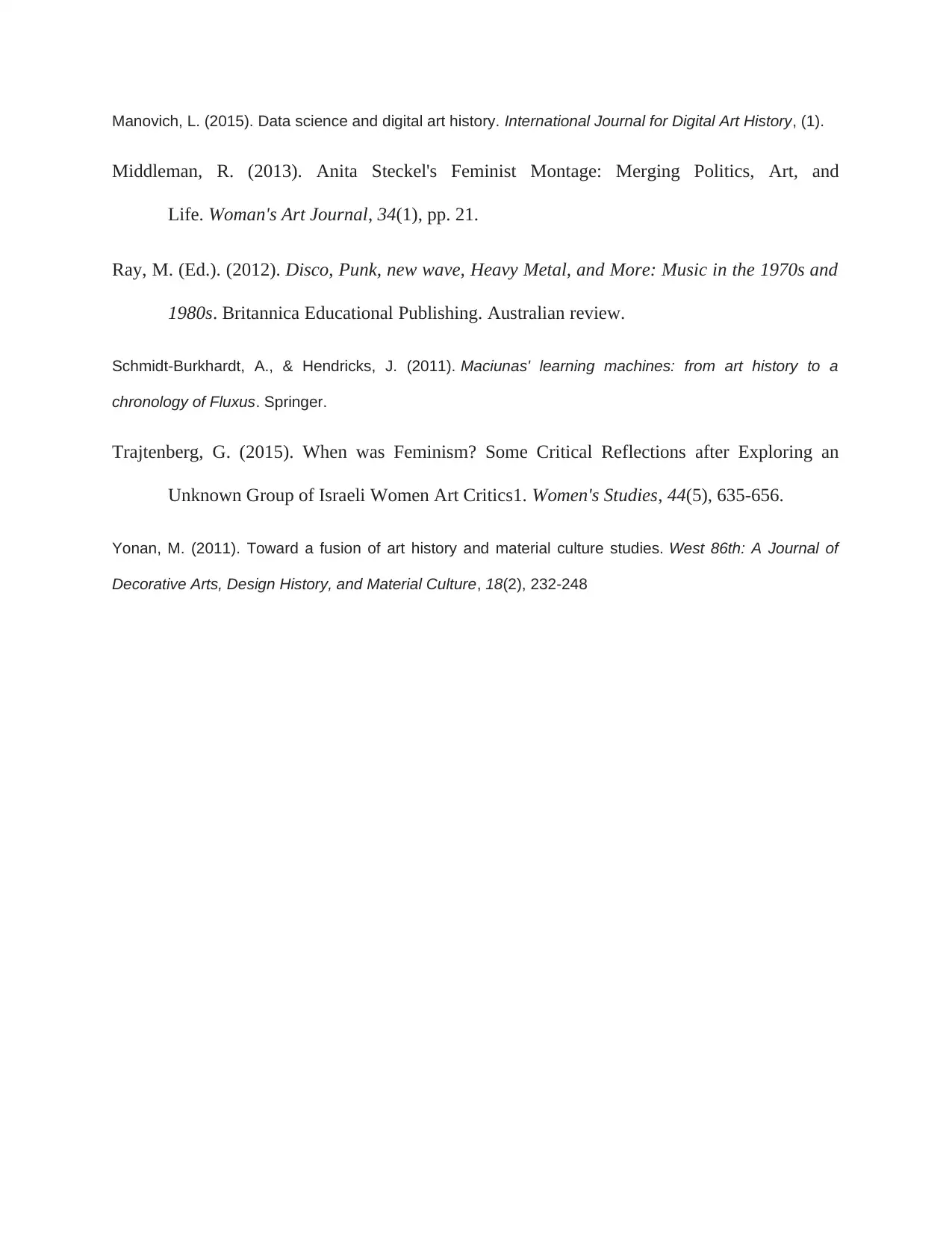
Manovich, L. (2015). Data science and digital art history. International Journal for Digital Art History, (1).
Middleman, R. (2013). Anita Steckel's Feminist Montage: Merging Politics, Art, and
Life. Woman's Art Journal, 34(1), pp. 21.
Ray, M. (Ed.). (2012). Disco, Punk, new wave, Heavy Metal, and More: Music in the 1970s and
1980s. Britannica Educational Publishing. Australian review.
Schmidt-Burkhardt, A., & Hendricks, J. (2011). Maciunas' learning machines: from art history to a
chronology of Fluxus. Springer.
Trajtenberg, G. (2015). When was Feminism? Some Critical Reflections after Exploring an
Unknown Group of Israeli Women Art Critics1. Women's Studies, 44(5), 635-656.
Yonan, M. (2011). Toward a fusion of art history and material culture studies. West 86th: A Journal of
Decorative Arts, Design History, and Material Culture, 18(2), 232-248
Middleman, R. (2013). Anita Steckel's Feminist Montage: Merging Politics, Art, and
Life. Woman's Art Journal, 34(1), pp. 21.
Ray, M. (Ed.). (2012). Disco, Punk, new wave, Heavy Metal, and More: Music in the 1970s and
1980s. Britannica Educational Publishing. Australian review.
Schmidt-Burkhardt, A., & Hendricks, J. (2011). Maciunas' learning machines: from art history to a
chronology of Fluxus. Springer.
Trajtenberg, G. (2015). When was Feminism? Some Critical Reflections after Exploring an
Unknown Group of Israeli Women Art Critics1. Women's Studies, 44(5), 635-656.
Yonan, M. (2011). Toward a fusion of art history and material culture studies. West 86th: A Journal of
Decorative Arts, Design History, and Material Culture, 18(2), 232-248
1 out of 10
Related Documents
Your All-in-One AI-Powered Toolkit for Academic Success.
+13062052269
info@desklib.com
Available 24*7 on WhatsApp / Email
![[object Object]](/_next/static/media/star-bottom.7253800d.svg)
Unlock your academic potential
© 2024 | Zucol Services PVT LTD | All rights reserved.




